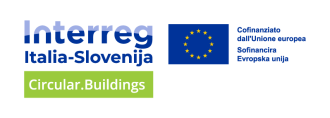222 questionnaires, 33 interviews: a clear picture of the use of innovations and circular economy tools in our territories and the real obstacles that prevent their widespread adoption.
The Field Analysis of the Circular.Buildings project concludes its first year of research by providing quantitative and qualitative data on the actual level of maturity of construction companies and professionals in Friuli Venezia Giulia and Slovenia in terms of digital innovations, good circular economy practices and development needs. Even more importantly, the analysis provides an in-depth understanding of the obstacles preventing the widespread adoption of these innovations and best practices: what are the real barriers that effectively prevent innovation and virtuous development in the cross-border construction sector?
KEY FIGURES (AND WHAT THEY TELL US)
222 questionnaires (107 on the Italian side, 115 on the Slovenian side) administered to 123 companies and 99 professionals and 33 engineers/architects and companies in the sector interviewed: this is the sample on which the in-depth research conducted over the last year by the Circular.Buildings project partners is based. An in-depth analysis that investigated:
The level of knowledge of good circular economy practices (the same ones analysed in the research conducted by the University of Udine)
The adoption of digital and innovative tools, including those based on artificial intelligence
The perception of the relevance of energy efficiency and circularity issues for players in the construction sector
The importance attributed to the network, both between Italian and Slovenian players and between the two sides of the border
The effectiveness of support systems for the sector
Priority development needs.
The picture that emerges is extremely complex, with some striking data. In particular, while operators claim to pay great attention to making plants last as long as possible, reducing consumption on construction sites, and managing and disposing of waste in order to maximise recycling, the level of adoption of good practices is low, and knowledge of digital and innovative tools that would maximise these processes is even lower. What is most striking is that BIM is still virtually unknown to many companies and even, in some cases, to professionals. It is also worth noting that at the bottom of the list, in all segments, are building sustainability certifications and component certifications for reuse, which are almost never considered important by operators in the sector.
THE 5 MAIN OBSTACLES TO CIRCULARITY IN CONSTRUCTION
The analysis identified some of the main obstacles to the adoption of sustainable practices, including:
1. The widespread idea that customers/the market do not demand or prefer traditional solutions. However, here is an interesting fact that gives pause for thought: many operators say that “the customer does not ask for it”, but most claim that they do not encounter resistance when proposing more durable or efficient solutions. The message is clear: we need to communicate the value better to the end customer.
2. Unclear or complex regulations.
3. High costs/insufficient savings with regard to the most innovative technologies.
4. Excessive bureaucracy.
5. Lack of skills/training on a par with lack of supply chain/infrastructure
THE 8 CONCRETE STEPS FOR DEVELOPMENT SUGGESTED BY OPERATORS IN THE SECTOR
The research also made it possible to gather interesting suggestions directly from operators in the sector. They cite the following as the most efficient solutions for the real promotion of the circular economy in construction:
1. Widespread, free or subsidised training for companies, professionals and clients
2. Stable and clear economic incentives for those who adopt circular solutions and digital tools.
3. Bureaucratic streamlining
4. Binding regulations with obligations/penalties and recycling quality targets (not just quantity).
5. Reduction/compensation of the costs of recycled materials and innovative technologies.
6. Demonstrative case studies and pilot construction sites that show real economic and environmental benefits
7. Cross-border clusters and networks with the world of research (materials marketplace, component banks, reuse depots).
8. Cross-border web portal with matching, marketplace, technical repository, training catalogue, regulatory helpdesk and tender/incentive bank.
INFO
The research is freely available at the link below.
If you would like to receive an email with the research attached, please contact our staff now by writing to: circular.buildings@ecipa.eu

